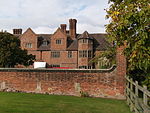White Ladies Priory
1536 disestablishments in EnglandChristian monasteries established in the 12th centuryEnglish Heritage sites in ShropshireMonasteries in ShropshireMonasteries of Canonesses Regular ... and 2 more
Ruins in ShropshireUse British English from October 2013

White Ladies Priory (often Whiteladies Priory), once the Priory of St Leonard at Brewood, was an English priory of Augustinian canonesses, now in ruins, in Shropshire, in the parish of Boscobel, some eight miles (13 km) northwest of Wolverhampton, near Junction 3 of the M54 motorway. Dissolved in 1536, it became famous for its role in the escape of Charles II of England after the Battle of Worcester in 1651. The name 'White Ladies' refers to the canonesses who lived there and who wore white religious habits.
Excerpt from the Wikipedia article White Ladies Priory (License: CC BY-SA 3.0, Authors, Images).White Ladies Priory
Shackerley Lane,
Geographical coordinates (GPS) Address Website External links Nearby Places Show on map
Geographical coordinates (GPS)
| Latitude | Longitude |
|---|---|
| N 52.6657 ° | E -2.2584 ° |
Address
White Ladies Priory
Shackerley Lane
WV7 3AB
England, United Kingdom
Open on Google Maps









